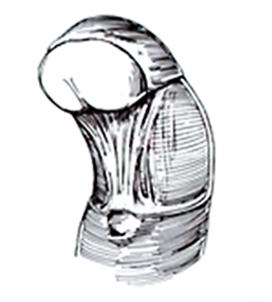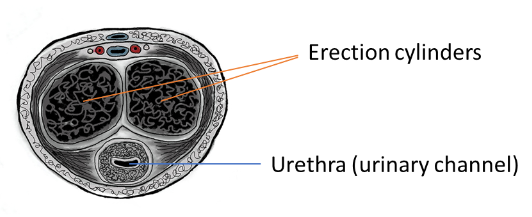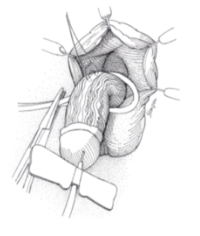Every day another 27 boys are born in the US who are diagnosed as having “hypospadias with chordee”. What does that mean? Can a boy have hypospadias without chordee, or chordee without hypospadias?
Hypospadias means the opening to the urinary channel is lower than it normally is. In addition, most boys with hypospadias also have shorter penis skin on the underside than on the topside, and in many boys the penis appears bent downwards.
Chordee derives from French and is commonly used by urologists to mean the penis is bent during an erection. Confusion arises, however, because the same word has also been used to explain why the penis is bent. The traditional concept of “chordee” was that bands of constricting tissues on the underside of the penis tethered its expansion during erections, and today many surgeons still believe this “chordee” needs to be removed to make the penis straight.
What urologists used to think (and some still do!)
This diagram illustrates the idea of chordee restricting erection and causing the penis to bend:

The fan-shaped lines extending from the urine opening to the head of the penis represent “chordee tissues” on the surface of the erection cylinders. For nearly 100 years, surgeons thought this was what caused penis curvature, by restricting expansion during erections
However, the advent of artificial erection in the 1970s to evaluate the penis during surgery proved that even the most thorough excision does not straighten the penis in the vast majority.
Nevertheless, because most boys with hypospadias appear to also have a bent penis, parents are typically informed that their son has “hypospadias with chordee.”
Because this is confusing, misleading, and erroneously lumps the real causes of penile curvature all into one word, Dr Snodgrass has encouraged urologists for many years to refer instead to “ventral penile curvature,” and we at the Hypospadias Specialty Center do not use the word chordee!
Why is the penis really bent?
There are two main reasons that the penis of a boy with hypospadias can be bent:
- Short penis skin on the underside (most common in boys with distal hypospadias)
- Short internal sheath enclosing the erection tissues (most common in boys with midshaft and proximal hypospadias, as well as some boys with distal hypospadias)
Short skin
Short skin on the underside is the most common reason why the penis is bent in those with distal hypospadias, where the urine opening is near the head of the penis. Nearly every boy with hypospadias has less penis skin and foreskin on the underside where the urine opening is than on the topside. In fact, the foreskin in these boys typically develops abnormally, leaving most on the top and little to none covering the head of the penis on the underside.
It is not difficult to understand that this shorter skin can tether the penis during an erection and pull it downwards. Some surgeons call this “skin chordee”, but it is simpler and more accurate to say the penis skin is shorter underneath.
When the cause of bending is short skin, the penis becomes straight when the skin incision is made at the very beginning of a hypospadias repair. Releasing the skin, known as “degloving,” removes the tension that was holding the penis down during erections in this circumstance. An artificial erection is then used to confirm when the skin is the only reason the penis is bent. When short skin is the issue, the penis should be straight when an erection is checked after releasing the short skin. Later in the operation the surgeon rearranges the penis skin to make it the same length on both the top and underside.
Short internal sheath
When artificial erection after the skin is released shows the penis is still bent, the usual reason is a short internal sheath surrounding the erection tissue.
The penis is two erection cylinders and a urethra, as shown in this diagram:

Diagram showing the side-by-side erection cylinders filled with erectile tissues enclosed in a sheath. The urethra is separate, but closely attached, underneath the cylinders.
During stimulation, the erectile tissues fill with blood and stretch the cylinders longer. The strong sheath surrounding them makes the penis hard.
In boys with hypospadias, the underside of that sheath can form shorter than the topside – similar to how the penis skin develops shorter on one side than on the other. When erection happens, that shorter side restricts normal expansion of the erection tissues and makes the penis bend.
This is not “chordee” on the outside of the sheath restricting it, it is the sheath itself causing the bending. Surgeons refer to this as “corporal disproportion.” We stopped using this term at the Hypospadias Specialty Center because it is also confusing, as it might suggest the erection tissues are deficient when it is actually only the sheath that is shorter on the underside.
How much can the penis be bent?
The penis is normally straight when it is erect. Downward curvature can range from 10 degrees to as much as 130 degrees during an erection. This bending usually occurs in the middle of the penis, but can be localized in the distal end near the head, or the proximal end near the scrotum. Wherever it is found, the curvature usually makes a smooth arc, rather than a sharp angle.
What is the usual curvature in distal versus proximal hypospadias?
When the hypospadias urinary opening is near the head of the penis it is usually straight after release of the short skin. In one out of every three patients, bending is found after the skin is released. This curvature is less than 30 degrees in half of these boys, and 30 degrees or more in the others.
Hypospadias with a lower urinary opening (proximal hypospadias) has curvature after release of the skin 80 percent of the time. This bending is also more severe, averaging 75 degrees.
How much curvature matters?
Men with penile curvature report that as little as 20 degrees of bending is enough to interfere with sexual intercourse and is associated with more unhealthy mental days (Menon et al, J Pedr Urol 2016). This diagram shows that extent of bending.

20 degrees of bending does not look like much but can interfere with sexual function.
The extent of bending also impacts healing after hypospadias surgery. We have found that curvature of 30 degrees or more can exert tension on the healing tissues to pull apart stitches and make fistulas or recurrent hypospadias from glans dehiscence.
How is straightening done?
Simply releasing the skin at the beginning of a hypospadias repair straightens bending due to short skin.
Curvature that persists after degloving the skin indicates the sheath around the erection cylinders is short on the underside. The potential remedies are to make the longer side shorter or the short side longer. The choice between these depends on how much bending there is.
Bending less than 30 degrees can reliably be straightened by making the longer side slightly smaller with a single “dorsal plication.” We do this by making a small incision into the sheath on the topside opposite where the penis is bent, and then stitching it closed with a strong suture, seen in the diagram. Repeat artificial erection is done to confirm the penis is straight.

Here a stitch is about to be tied that will slightly shorten the longer topside of the penis opposite where it is bent on the underside.
However, when the bend is more than 30 degrees, the tension that develops on the curved underside during natural erections after surgery is often too much for any suture to withstand. As a result, these postoperative erections can pull the penis back over.
This is easy to understand. Imagine trying to bend a fully erect straight penis by 30 degrees and it quickly becomes clear how much force there is within an erection. Consequently, it is not surprising that one, or even more than one, stitch cannot hold the penis straight erection after erection indefinitely when the root cause of the bending (the shorter underside) is not corrected.
We have found that the most common reason for such complications as recurrent fistulas and glans dehiscence after hypospadias repair is persistent or recurrent penis curvature when a dorsal plication was done for bending that was more than 30 degrees.
Therefore, when curvature is 30 degrees or more, it is best to make the shorter underside longer. Surgeons call this “ventral lengthening.”
At the Hypospadias Specialty Center we do ventral lengthening using a method Dr Snodgrass developed in the late 1990s. We move the urine channel off to the side to expose the area where the sheath around the erection cylinders is too short. Then we draw a line across the most bent area, plus a second and third lines a short distance proximal and distal to the first one, as shown in the picture.

Artificial erection during surgery shows the bent penis, with 3 lines drawn where the incisions will be made in the sheath to straighten the curvature.
Next, we incise through the sheath along these lines, extending down to but not into the erection tissues. We have documented that these “3 corporotomies” straighten even the most severe bending reliably and durably.
The incisions also make the penis an average of 30 percent longer, which is especially important for boys with severe hypospadias since their penis is often relatively short.
What happens if bending comes back?
There are several serious consequences when surgery does not make, and keep, the penis straight. First, as explained above, tension that develops along the bent underside during natural erections that boys have every day pulls at the repair and can make fistulas and other complications. Then, if the surgeon tries to repair the complication and does not think to check an artificial erection and make the penis straight, the fistula or glans dehiscence is likely to happen again.
Most of the boys we see with persistent or recurrent ventral curvature also have short penile skin on the underside. This too can happen from tension exerted by erections on that skin while it is healing after the hypospadias repair.
Even if the penis manages to heal, as already discussed, residual bending of only 20 degrees is enough to cause sexual dysfunction when the boy grows into a man with a bent penis.
For all these reasons, straightening the bent penis is the foundation for successful hypospadias surgery.
What is chordee without hypospadias?
There are some boys who are born with a normal urine opening but have a bent penis during erections. Because the urine opening is in the normal location, these boys are said to have chordee without hypospadias. Most of those boys also have the abnormal foreskin seen in boys with hypospadias.
Because it can cause sexual problems, this curvature is corrected by dorsal plication when it is less than 30 degrees, and by ventral lengthening when it is more severe.
Comprehensive Care at the Hypospadias Specialty Center
Although hypospadias and penis curvature are said to be common problems, all birth defects are unusual and these penis conditions occur in less than 1% of boys. Furthermore, the surgery to repair hypospadias and straighten penis curvature is delicate, requiring technical precision.
Our surgeons at the Hypospadias Specialty Center are dedicated to making the penis born with hypospadias and curvature normal. To that end, they keep databases with all their surgeries and review them often to be certain our results are among the best. And when they find a problem, our surgeons work to improve the operation and then document that the results get better.
All hypospadias repairs require a surgical assistant. Commonly these are urology trainees or nurses. At the Hypospadias Specialty Center a team of two experienced surgeons work together during every operation to achieve the best results.
We also work with the same anesthesiologist and team of surgical techs and nurses who all have extensive experience with hypospadias.
Get in touch with us today to schedule a consultation.

Leave a Reply